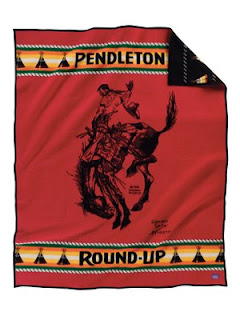Despite the bleak outlook, textile production at Pendleton was not over. In February 16, 1909, ownership of the Pendleton Woolen Mills changed hands. New owners, from a prominent family with a history of successful textile businesses, Clarence and Roy Bishop “eagerly accepted the challenge of the management of the new company” (Lomax 274) The Bishops felt that the mill needed substantial physical and mechanical improvements before the business could resume. Working alongside a construction crew, the Bishops oversaw the building of a new three-story cement facility on land adjacent to the Union Pacific Railroad Company’s tracks. By September 1, 1909 construction was complete (274). The Bishops intended to continue the Pendleton production of Indian blankets and robes. The brothers employed Joe Rounsley, of the Philadelphia Textile school, to develop designs for the company’s Indian blankets. Rounsley’s product was “pure art, conceived by…living with the Indians” (276). In 1912 the Bishops procured the recently foreclosed Wahougal Mill in Washougal Washington (277). This purchased marked the beginning of a series of expansion moves the Bishops would coordinate. The expansions were used as a way to diversify product lines. During WWI Washougal produced army blankets while the Pendleton mill continued to produce Indian products (277) After the war, Pendleton began to develop virgin wool products and market them under the Pendleton blue and gold brand (279). By the late 1940’s Pendleton Woolen Mills Inc. came to include facilities as far away as Nebraska (300). Today Pendleton Woolen Mills is still operated by the Bishop family, and consists of seven facilities and 75 stores. The mill located in Pendleton Oregon continues to be the site of all Pendleton Indian blanket production (“About Pendleton”). I'm hoping to find information regarding the ecological impact of the Indian blanket production that goes on at Pendleton. I am concerned that the intense colors of the blankets may mean that significant pollution from dyes is part of the process. So far I have found very little information. What I do know is that Pendleton has taken a public position advocating sustainability. Of course in this political and social climate this is a smart market move, but it is still significant. Image of Pendleton Round-Up Blanket Lomax, Alfred F. 1974. Later Woolen Mills in Oregon, First Edition, Binfords & Mort,Portland, 301. 
Achievement unlocked – 52 movies
5 years ago


5 comments:
I thought you said you did find epa info and that pendleton mills score really high on the "clean" scale (meaning they're pretty damn clean).
im not sureif i should be cheering for Pendleton for hanging in there or be disturbed that they have...keep me posted!
i like the pic.
I hope the mill get a good report!
how about the sheep? How are they treated? just wondering!
keep cool! Love A
Just for fun you can read Ken Kesey's Last go Round about the Pendleton Round Up in 1911 a final run-off for top cowboy between Johnathan Spain, Nez Perce Sundown Jackson and African American George Taylor (I think). Great true story. Spoiler warning - the white guy wins.
Nice and beautiful article that is important for us.
dog waste bags
Post a Comment